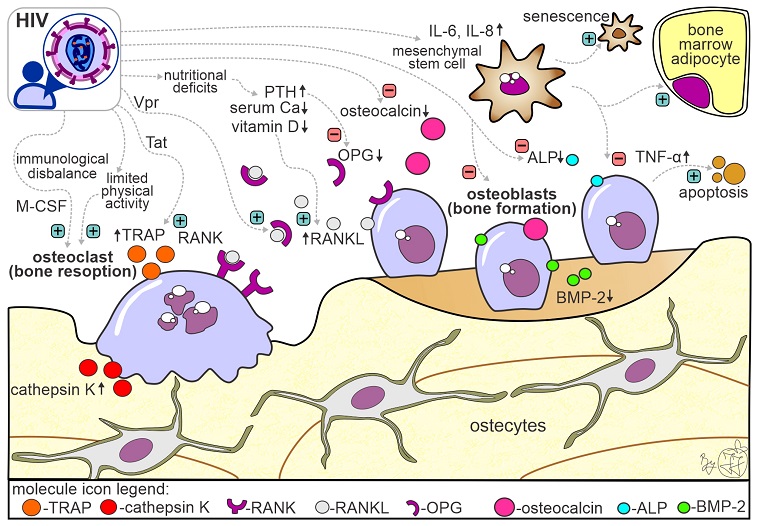Nikhil Prasad Fact checked by:Thailand Medical News Team Jul 30, 2024 1 year, 4 months, 1 week, 2 days, 5 hours, 53 minutes ago
HIV News: Researchers from the University of Belgrade have revealed significant findings on bone health issues among people living with HIV/AIDS (PLWHIV). This
HIV News report delves into the latest study, shedding light on the complexities of bone fragility in this population and emphasizing the importance of a comprehensive approach to understanding and managing these challenges.
 Schematic representation of molecular mechanisms contributing to bone alterations in patients living with HIV/AIDS. The figure contains multiple factors leading to bone changes in PLWHIV, with an emphasis on the factors that cause reduced bone formation and factors that stimulate bone resorption (the activating effect is marked with a green sign, while the deactivating effect is marked with a red sign; upward arrow symbol indicate higher concentrations, while downward arrow symbol indicate lower concentration of the molecule). Abbreviations: PTH—parathyroid hormone; IL—interleukin; TNF-α—tumor necrosis factor-α; ALP—alkaline phosphatase; OC—osteocalcin; OPG—osteoprotegerin; Vpr—viral protein R; M-CSF—macrophage colony-stimulating factor; Tat—trans-activator of transcription; RANK—receptor activator for nuclear factor-kappa B; RANKL—receptor activator for nuclear factor kappa B ligand; BMP-2—bone morphogenic factor-2.
Understanding Bone Changes in HIV
Schematic representation of molecular mechanisms contributing to bone alterations in patients living with HIV/AIDS. The figure contains multiple factors leading to bone changes in PLWHIV, with an emphasis on the factors that cause reduced bone formation and factors that stimulate bone resorption (the activating effect is marked with a green sign, while the deactivating effect is marked with a red sign; upward arrow symbol indicate higher concentrations, while downward arrow symbol indicate lower concentration of the molecule). Abbreviations: PTH—parathyroid hormone; IL—interleukin; TNF-α—tumor necrosis factor-α; ALP—alkaline phosphatase; OC—osteocalcin; OPG—osteoprotegerin; Vpr—viral protein R; M-CSF—macrophage colony-stimulating factor; Tat—trans-activator of transcription; RANK—receptor activator for nuclear factor-kappa B; RANKL—receptor activator for nuclear factor kappa B ligand; BMP-2—bone morphogenic factor-2.
Understanding Bone Changes in HIV
HIV has long been associated with various health complications, but bone health is an area that often goes unnoticed. The study highlights that skeletal alterations such as osteopenia, osteoporosis, and increased bone fragility are becoming more prevalent as the life expectancy of PLWHIV increases due to effective combined antiretroviral therapy (cART). The study explores the intricate relationship between HIV, antiretroviral therapy, and bone health, providing a clearer picture of the challenges faced by this population.
The Scope of the Study
The research team, comprising Jelena Jadzic, Gordana Dragovic, Relja Lukic, Bozana Obradovic, and Marija Djuric, conducted an extensive literature review to assess contemporary findings on bone health in PLWHIV. Their work underscores the need for a multi-scale approach to investigate bone fragility, focusing on various levels of bone hierarchical organization. Despite the frequent reports of low bone mineral density (BMD) in PLWHIV, the study identifies significant gaps and ambiguities that necessitate further investigation.
Key Findings
The research points to several crucial findings regarding bone health in PLWHIV:
-Increased Fracture Risk: PLWHIV are at least twice as likely to suffer from fragility fractures compared to the general population. This risk is particularly high for vertebral, femoral, and wrist fractures.
-Gender-Specif
ic Concerns: Women living with HIV/AIDS (WLWHIV) face unique challenges, especially postmenopausal women, who are at a higher risk of bone fractures.
-Impact of Antiretroviral Therapy: Certain cART regimens, notably those containing tenofovir disoproxil fumarate (TDF), have been linked to adverse skeletal effects. However, switching to tenofovir alafenamide (TAF)-based regimens has shown potential in mitigating these effects.
Detailed Examination of Bone Health
The study elaborates on the importance of BMD measurement using dual-energy X-ray absorptiometry (DXA) as a standard clinical assessment tool for bone fragility. However, it also emphasizes the limitations of relying solely on BMD, advocating for the inclusion of other bone properties in the assessment. This comprehensive approach is crucial for accurately understanding bone fragility and improving individualized patient care.
The Role of Antiretroviral Therapy
The adverse effects of certain cART regimens on bone health have been a significant concern. The study provides a detailed analysis of various cART-induced bone alterations, highlighting the importance of choosing appropriate regimens to minimize these risks. For instance, TDF has been associated with a decrease in bone mass and adverse kidney effects, leading to recommendations for TAF as a safer alternative.
The Need for a Hierarchical Approach
Understanding bone fragility in PLWHIV requires a multi-scale approach that considers the hierarchical organization of bone structure. The study suggests that future research should focus on assessing bone properties at various levels, from the macro to the nano-scale. This approach can provide deeper insights into the determinants of bone fragility and lead to more effective prevention and treatment strategies.
Future Directions
The study concludes by emphasizing the need for further research to address the gaps in our understanding of bone health in PLWHIV. By integrating clinical data and adopting a hierarchical approach to bone assessment, researchers can develop patient-specific diagnostic algorithms to predict fracture risk more accurately. This will ultimately lead to better prevention, diagnosis, and treatment of skeletal disorders in this population.
The study findings were published in the peer-reviewed Journal of Personalized Medicine.
https://www.mdpi.com/2075-4426/14/8/791
For the latest
HIV News, keep on logging to Thailand Medical News.
Read Also:
https://www.thailandmedical.news/news/hiv-1-s-new-tactic-to-evade-immune-attack-hijacking-human-microrna
https://www.thailandmedical.news/news/new-insights-into-how-hiv-disrupts-autophagy-and-impacts-heart-health
